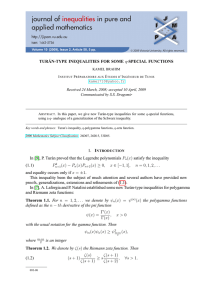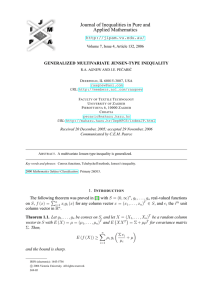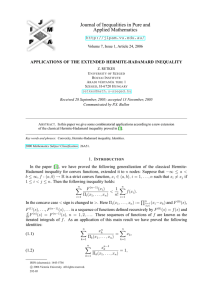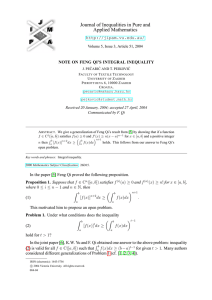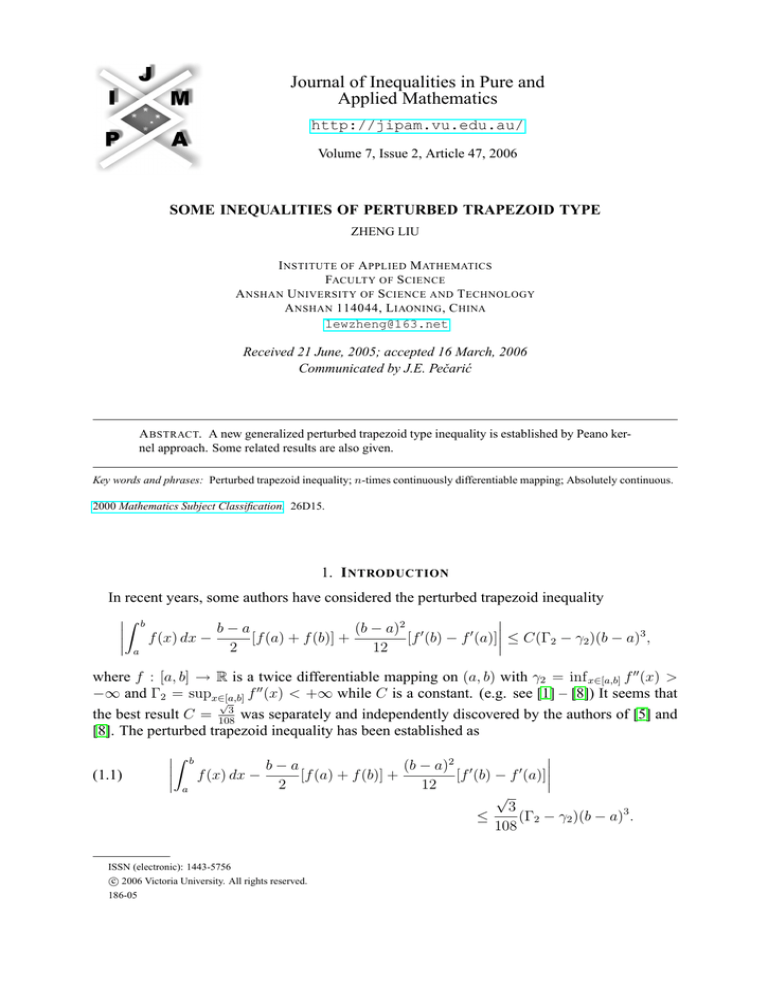
Journal of Inequalities in Pure and
Applied Mathematics
http://jipam.vu.edu.au/
Volume 7, Issue 2, Article 47, 2006
SOME INEQUALITIES OF PERTURBED TRAPEZOID TYPE
ZHENG LIU
I NSTITUTE OF A PPLIED M ATHEMATICS
FACULTY OF S CIENCE
A NSHAN U NIVERSITY OF S CIENCE AND T ECHNOLOGY
A NSHAN 114044, L IAONING , C HINA
lewzheng@163.net
Received 21 June, 2005; accepted 16 March, 2006
Communicated by J.E. Pečarić
A BSTRACT. A new generalized perturbed trapezoid type inequality is established by Peano kernel approach. Some related results are also given.
Key words and phrases: Perturbed trapezoid inequality; n-times continuously differentiable mapping; Absolutely continuous.
2000 Mathematics Subject Classification. 26D15.
1. I NTRODUCTION
In recent years, some authors have considered the perturbed trapezoid inequality
Z b
2
b
−
a
(b
−
a)
0
0
≤ C(Γ2 − γ2 )(b − a)3 ,
f
(x)
dx
−
[f
(a)
+
f
(b)]
+
[f
(b)
−
f
(a)]
2
12
a
where f : [a, b] → R is a twice differentiable mapping on (a, b) with γ2 = inf x∈[a,b] f 00 (x) >
−∞ and Γ2 = supx∈[a,b] f 00 (x) < +∞ while C is a constant. (e.g. see [1] – [8]) It seems that
√
the best result C = 1083 was separately and independently discovered by the authors of [5] and
[8]. The perturbed trapezoid inequality has been established as
(1.1)
Z b
2
b
−
a
(b
−
a)
0
0
f
(x)
dx
−
[f
(a)
+
f
(b)]
+
[f
(b)
−
f
(a)]
2
12
a
√
3
≤
(Γ2 − γ2 )(b − a)3 .
108
ISSN (electronic): 1443-5756
c 2006 Victoria University. All rights reserved.
186-05
2
Z HENG L IU
Moreover, we can also find in [5] the following two perturbed trapezoid inequalities as
Z b
b−a
(b − a)2 0
0
[f (a) + f (b)] +
[f (b) − f (a)]
(1.2)
f (x) dx −
2
12
a
1
≤
(Γ3 − γ3 )(b − a)4 ,
384
where f : [a, b] → R is a third-order differentiable mapping on (a, b) with γ3 = inf x∈[a,b] f 000 (x)
> −∞ and Γ3 = supx∈[a,b] f 000 (x) < +∞, and
Z b
2
b
−
a
(b
−
a)
0
0
≤ 1 M4 (b − a)5 ,
(1.3)
f
(x)
dx
−
[f
(a)
+
f
(b)]
+
[f
(b)
−
f
(a)]
720
2
12
a
where f : [a, b] → R is a fourth-order differentiable mapping on (a, b) with M4 = sup |f (4) (x)|
x∈[a,b]
< +∞.
The purpose of this paper is to extend these above results to a more general version by choosing appropriate harmonic polynomials such as the Peano kernel. A new generalized perturbed
trapezoid type inequality is established and some related results are also given.
2. F OR D IFFERENTIABLE M APPINGS W ITH B OUNDED D ERIVATIVES
Theorem 2.1. Let f : [a, b] → R be an n-times continuously differentiable mapping, n ≥ 2 and
such that Mn := supx∈[a,b] |f (n) (x)| < ∞. Then
Z b
b−a
(b − a)2 0
[f (a) + f (b)] +
[f (b) − f 0 (a)]
(2.1) f (x) dx −
2
12
a
n−1
[ 2 ]
X k(k − 1)(b − a)2k+1
a + b (2k)
−
f
3(2k + 1)!22k−2
2
k=2
√3(b−a)3
if n = 2;
54
≤ Mn ×
n(n−2)(b−a)n+1
if n ≥ 3,
3(n+1)!2n
where [ n−1
] denotes the integer part of
2
n−1
.
2
Proof. It is not difficult to find the identity
Z b
n
(2.2) (−1)
Tn (x)f (n) (x) dx
a
Z b
b−a
(b − a)2 0
[f (a) + f (b)] +
[f (b) − f 0 (a)]
=
f (x) dx −
2
12
a
]
[ n−1
2
X k(k − 1)(b − a)2k+1
a+b
(2k)
f
,
−
2k−2
3(2k
+
1)!2
2
k=2
where Tn (x) is the kernel given by
(x−a)n (b−a)(x−a)n−1 (b−a)2 (x−a)n−2
+
if x ∈ a, a+b
,
n! −
2(n−1)!
12(n−2)!
2
(2.3)
Tn (x) =
(x−b)n (b−a)(x−b)n−1 (b−a)2 (x−b)n−2
+
+ 12(n−2)!
if x ∈ a+b
,b .
n!
2(n−1)!
2
J. Inequal. Pure and Appl. Math., 7(2) Art. 47, 2006
http://jipam.vu.edu.au/
S OME I NEQUALITIES OF P ERTURBED T RAPEZOID T YPE
3
Using the identity (2.2), we get
Z b
b−a
(b − a)2 0
(2.4) f (x) dx −
[f (a) + f (b)] +
[f (b) − f 0 (a)]
2
12
a
]
[ n−1
2
2k+1
X
a + b k(k − 1)(b − a)
f (2k)
−
2k−2
3(2k + 1)!2
2
k=2
Z b
Z b
(n)
= Tn (x)f (x) dx ≤ Mn
|Tn (x)| dx.
a
a
For brevity, we put
(x − a)n (b − a)(x − a)n−1 (b − a)2 (x − a)n−2
−
+
n!
2(n − 1)!
12(n − 2)!
(x − a)n−2
n(b − a)(x − a) n(n − 1)(b − a)2
2
=
(x − a) −
+
,
n!
2
12
a+b
x ∈ a,
2
Pn (x) :=
and
(x − b)n (b − a)(x − b)n−1 (b − a)2 (x − b)n−2
+
+
n!
2(n − 1)!
12(n − 2)!
n−2
(x − b)
n(b − a)(x − b) n(n − 1)(b − a)2
2
=
(x − b) +
+
,
n!
2
12
a+b
x∈
,b .
2
Qn (x) :=
It is clear that Pn (x) and Qn (x) are symmetric with respect to the line x =
symmetric with respect to the point ( a+b
, 0) for n odd. Therefore,
2
b
Z
Z
|Tn (x)| dx = 2
a+b
2
for n even, and
a+b
2
|Pn (x)| dx
Z (b − a)n+1 1 n−2 2
n(n − 1) =
t − nt +
t
dt
n!2n
3
0
h
n−2
by substitution x = a + b−a
t,
and
it
is
easy
to
find
that
r
(t)
:=
t
t2 − nt +
n
2
always nonnegative on [0, 1] for n ≥ 3. Thus we have
Z 1
Z 1
n(n − 1)
n(n − 2)
n−2
2
|rn (t)| dt =
t
t − nt +
dt =
3
3(n + 1)
0
0
a
a
n(n−1)
3
i
is
for n ≥ 3, and
Z
0
1
1
2
2 |r2 (t)| dt =
t − 2t + 3 dt
0
Z t0 Z 1
2
2
2
2
=
t − 2t +
dt −
t − 2t +
dt,
3
3
0
t0
Z
J. Inequal. Pure and Appl. Math., 7(2) Art. 47, 2006
http://jipam.vu.edu.au/
4
Z HENG L IU
√
where t0 = 1 −
(2.5)
3
3
is the unique zero of r2 (t) in (0, 1). Hence,
√
3
Z b
3(b−a)
,
n = 2,
54
|Tn (x)| dx =
n(n−2)(b−a)n+1 , n ≥ 3.
a
3(n+1)!2n
Consequently, the inequality (2.1) follows from (2.4) and (2.5).
Remark 2.2. If in the inequality (2.1) we choose n = 2, 3, 4, then we get
Z b
√
2
b
−
a
(b
−
a)
0
0
≤ 3 M2 (b − a)3 ,
f
(x)
dx
−
[f
(a)
+
f
(b)]
+
[f
(b)
−
f
(a)]
2
12
54
a
Z b
2
b−a
(b − a) 0
0
≤ 1 M3 (b − a)4
f
(x)
dx
−
[f
(a)
+
f
(b)]
+
[f
(b)
−
f
(a)]
192
2
12
a
and the inequality (1.3), respectively.
For convenience in further discussions, we will now collect some technical results related to
(2.3) which are not difficult to obtain by elementary calculus as:
Z b
n odd,
0,
(2.6)
Tn (x) dx =
n(n−2)(b−a)n+1 , n even.
a
3(n+1)!2n
(2.7)
(2.8)
max |Tn (x)| =
x∈[a,b]
(b−a)2
,
12
√
n = 2,
3(b−a)3
,
216
n = 3,
(n−1)(n−3)(b−a)n
,
3(n!)2n
Z b
1
max T2m (x) −
T2m (x) dx =
x∈[a,b]
b−a a
n ≥ 4.
(b−a)4
,
720
m = 2,
(8m3 −16m2 +2m+3)(b−a)2m
,
3(2m+1)!22m
m ≥ 3.
3. B OUNDS I N T ERMS OF S OME L EBESGUE N ORMS
Theorem 3.1. Let f : [a, b] → R be a mapping such that the derivative f (n−1) (n ≥ 2) is
absolutely continuous on [a, b]. If f (n) ∈ L∞ [a, b], then we have
Z b
b−a
(b − a)2 0
(3.1) f (x) dx −
[f (a) + f (b)] +
[f (b) − f 0 (a)]
2
12
a
[ n−1
]
2
2k+1
X
k(k − 1)(b − a)
a + b f (2k)
−
2k−2
3(2k + 1)!2
2
k=2
√
3
3(b−a)
,
n = 2,
54
≤ kf (n) k∞ ×
n(n−2)(b−a)n+1 , n ≥ 3,
3(n+1)!2n
where [ n−1
] denotes the integer part of
2
Lebesgue norm on L∞ [a, b].
n−1
2
and kf (n) k∞ := ess supx∈[a,b] |f (n) (x)| is the usual
The proof of inequality (3.1) is similar to the proof of inequality (2.1) and so is omitted.
J. Inequal. Pure and Appl. Math., 7(2) Art. 47, 2006
http://jipam.vu.edu.au/
S OME I NEQUALITIES OF P ERTURBED T RAPEZOID T YPE
5
Theorem 3.2. Let f : [a, b] → R be a mapping such that the derivative f (n−1) (n ≥ 2) is
absolutely continuous on [a, b]. If f (n) ∈ L1 [a, b], then we have
(3.2)
Z b
b−a
(b − a)2 0
f (x) dx −
[f (a) + f (b)] +
[f (b) − f 0 (a)]
2
12
a
n−1
[ 2 ]
X k(k − 1)(b − a)2k+1
a + b (2k)
−
f
3(2k + 1)!22k−2
2
k=2
(b−a)2
,
12
√
3(b−a)3
≤ kf (n) k1 ×
,
216
(n−1)(n−3)(b−a)n
3(n!)2n
where kf (n) k1 :=
Rb
a
n = 2,
n = 3,
, n ≥ 4,
|f (x)| dx is the usual Lebesgue norm on L1 [a, b].
Proof. By using the identity (2.2), we get
Z b
b−a
(b − a)2 0
f
(x)
dx
−
[f
(a)
+
f
(b)]
+
[f (b) − f 0 (a)]
2
12
a
[ n−1
]
2
2k+1
X
k(k − 1)(b − a)
a + b −
f (2k)
2k−2
3(2k + 1)!2
2
k=2
Z b
Z b
(n)
= Tn (x)f (x) dx ≤ max |Tn (x)|
|f (n) (x)| dx.
a
x∈[a,b]
a
Then the inequality (3.2) follows from (2.7).
4. N ON -S YMMETRIC B OUNDS
Theorem 4.1. Let f : [a, b] → R be a mapping such that the derivative f (n) (n ≥ 2) is integrable
with γn = inf x∈[a,b] f (n) (x) > −∞ and Γn = supx∈[a,b] f (n) (x) < +∞. Then we have
(4.1)
Z b
b−a
(b − a)2 0
f
(x)
dx
−
[f
(a)
+
f
(b)]
+
[f (b) − f 0 (a)]
2
12
a
n−1
[ 2 ]
X k(k − 1)(b − a)2k+1
a + b f (2k)
−
2k−2
3(2k + 1)!2
2
k=2
√3(b−a)3
,
54
Γn − γn
≤
×
n(n−2)(b−a)n+1
2
3(n+1)!2n
J. Inequal. Pure and Appl. Math., 7(2) Art. 47, 2006
n = 2,
, n ≥ 3 and odd,
http://jipam.vu.edu.au/
6
(4.2)
Z HENG L IU
Z b
b−a
(b − a)2 0
[f
(a)
+
f
(b)]
+
[f (b) − f 0 (a)]
f
(x)
dx
−
2
12
a
[ n−1
]
2
2k+1
X k(k − 1)(b − a)
a + b (2k)
−
f
3(2k + 1)!22k−2
2
k=2
≤ [f (n−1) (b) − f (n−1) (a) − γn (b − a)]
(b−a)2
,
12
√
3(b−a)3
×
,
216
(n−1)(n−3)(b−a)n
3(n!)2n
(4.3)
n = 3,
, n ≥ 5 and odd,
Z b
b−a
(b − a)2 0
f
(x)
dx
−
[f
(a)
+
f
(b)]
+
[f (b) − f 0 (a)]
2
12
a
n−1
[ 2 ]
X k(k − 1)(b − a)2k+1
a + b (2k)
−
f
3(2k + 1)!22k−2
2
k=2
≤ [Γn (b − a) − f (n−1) (b) + f (n−1) (a)]
(b−a)2
,
12
√
3(b−a)3
×
,
216
(n−1)(n−3)(b−a)n
3(n!)2n
(4.4)
n = 2,
n = 2,
n = 3,
, n ≥ 5 and odd,
Z b
b−a
(b − a)2 0
f
(x)
dx
−
[f
(a)
+
f
(b)]
+
[f (b) − f 0 (a)]
2
12
a
n−1
[ 2 ]
X k(k − 1)(b − a)2k+1
a+b
(2k)
−
f
3(2k + 1)!22k−2
2
k=2
m(m − 1)(b − a)2m (2m−1)
(2m−1)
−
[f
(b) − f
(a)]
2m−2
3(2m + 1)!2
≤ [f (2m−1) (b) − f (2m−1) (a) − γ2m (b − a)]
(b−a)4
720 ,
×
(8m3 −16m2 +2m+3)(b−a)2m
3(2m+1)!22m
(4.5)
m = 2,
, m ≥ 3,
Z b
b−a
(b − a)2 0
f
(x)
dx
−
[f
(a)
+
f
(b)]
+
[f (b) − f 0 (a)]
2
12
a
[ n−1
]
2
X
k(k − 1)(b − a)2k+1 (2k) a + b
f
−
3(2k + 1)!22k−2
2
k=2
m(m − 1)(b − a)2m (2m−1)
(2m−1)
−
[f
(b)
−
f
(a)]
3(2m + 1)!22m−2
J. Inequal. Pure and Appl. Math., 7(2) Art. 47, 2006
http://jipam.vu.edu.au/
S OME I NEQUALITIES OF P ERTURBED T RAPEZOID T YPE
≤ [Γ2m (b − a) − f (2m−1) (b) + f (2m−1) (a)]
7
(b−a)4
,
720
m = 2,
(8m3 −16m2 +2m+3)(b−a)2m
,
3(2m+1)!22m
m ≥ 3.
Proof. For n odd and n = 2, by (2.2) and (2.6) we get
n
Z
(−1)
a
b
Tn (x)[f (n) (x) − C] dx
Z b
b−a
(b − a)2 0
=
f (x) dx −
[f (a) + f (b)] +
[f (b) − f 0 (a)]
2
12
a
]
[ n−1
2
X k(k − 1)(b − a)2k+1
a+b
(2k)
−
f
.
3(2k + 1)!22k−2
2
k=2
where C ∈ R is a constant.
n
If we choose C = γn +Γ
, then we have
2
Z b
(b − a)2 0
b−a
[f (a) + f (b)] +
[f (b) − f 0 (a)]
f (x) dx −
2
12
a
n−1
[ 2 ]
Z
X k(k − 1)(b − a)2k+1
a + b Γn − γn b
(2k)
−
f
|Tn (x)| dx.
≤
3(2k + 1)!22k−2
2
2
a
k=2
and hence the inequality (4.1) follows from (2.5).
If we choose C = γn , then we have
Z b
b−a
(b − a)2 0
f
(x)
dx
−
[f
(a)
+
f
(b)]
+
[f (b) − f 0 (a)]
2
12
a
[ n−1
]
Z b
2
2k+1
X
k(k − 1)(b − a)
a + b (2k)
−
f
max |Tn (x)|
|f (n) (x) − γn | dx,
≤ x∈[a,b]
2k−2
3(2k
+
1)!2
2
a
k=2
and hence the inequality (4.2) follows from (2.7).
Similarly we can prove that the inequality (4.3) holds.
By (2.2) and (2.6) we can also get
Z b
b−a
(b − a)2 0
[f
(a)
+
f
(b)]
+
[f (b) − f 0 (a)]
f
(x)
dx
−
2
12
a
n−1
[ 2 ]
X k(k − 1)(b − a)2k+1
a+b
(2k)
−
f
2k−2
3(2k
+
1)!2
2
k=2
m(m − 1)(b − a)2m (2m−1)
(2m−1)
−
[f
(b)
−
f
(a)]
3(2m + 1)!22m−2
Z b Z b
1
2m
=
T2m (x) −
T2m (x) dx [f (x) − C] dx ,
b−a
a
a
where C ∈ R is a constant.
J. Inequal. Pure and Appl. Math., 7(2) Art. 47, 2006
http://jipam.vu.edu.au/
8
Z HENG L IU
If we choose C = γ2m , then we have
Z b
(b − a)2 0
b−a
[f
(a)
+
f
(b)]
+
[f (b) − f 0 (a)]
f
(x)
dx
−
2
12
a
]
[ n−1
2
X
k(k − 1)(b − a)2k+1 (2k) a + b
f
−
3(2k + 1)!22k−2
2
k=2
m(m − 1)(b − a)2m (2m−1)
(2m−1)
−
[f
(b)
−
f
(a)]
3(2m + 1)!22m−2
Z b
Z
b (2m)
1
≤ max T2m (x) −
T2m (x) dx
|f
(x) − γ2m | dx
x∈[a,b]
b−a
a
a
and hence the inequality (4.4) follows from (2.8).
Similarly we can prove that the inequality (4.5) holds.
Remark 4.2. It is not difficult to find that the inequality (4.1) is sharp in the sense that we
can choose
R x fR yto attain the equality in (4.1). Indeed, for n = 2, we construct the function
f (x) = a a j(z) dz dy, where
√
√
(3+ 3)a+(3− 3)b
Γ
,
a
≤
x
<
,
2
6
√
√
√
√
(3+ 3)a+(3− 3)b
(3− 3)a+(3+ 3)b
j(x) =
,
≤x<
γ2 ,
6
6
√
√
3)b
Γ2 , (3− 3)a+(3+
≤ x ≤ b,
6
and for n ≥ 3 and odd, we construct the function
Z x Z yn Z y2
f (x) =
···
j(y1 ) dy1 · · · dyn−1 dyn ,
a
a
a
where
j(x) =
Γn , a ≤ x <
γ ,
n
a+b
2
a+b
,
2
≤ x ≤ b.
Remark 4.3. If in the inequality (4.1) we choose n = 2, 3, then we recapture the inequalities
(1.1) and (1.2), respectively.
R EFERENCES
[1] P. CERONE, On perturbed trapezoidal and midpoint rules, Korean J. Comput. Appl. Math., 2 (2002),
423–435.
[2] P. CERONE AND S.S. DRAGOMIR, Trapezoidal type rules from an inequalities point of view,
Handbook of Analytic-Computational Methods in Applied Mathematics, CRC Press N.Y.(2000), 65–
134.
[3] P. CERONE, S.S. DRAGOMIR AND J. ROUMELIOTIS, An inequality of Ostrowski-Grüss type
for twice differentiable mappings and applications in numerical integration, Kyungpook Math. J., 39
(1999), 331–341.
[4] X.L. CHENG, Improvement of some Ostrowski-Grüss type inequalities, Comput. Math. Appl., 42
(2001), 109–114.
J. Inequal. Pure and Appl. Math., 7(2) Art. 47, 2006
http://jipam.vu.edu.au/
S OME I NEQUALITIES OF P ERTURBED T RAPEZOID T YPE
9
[5] X.L. CHENG AND J. SUN, A note on the perturbed trapezoid inequality, J. Inequal. in Pure and
Appl. Math., 3(2) (2002), Art. 29. [ONLINE: http://jipam.vu.edu.au/article.php?
sid=181].
[6] S.S. DRAGOMIR, P. CERONE AND A. SOFO, Some remarks on the trapezoid rule in numerical
integration, Indian J. of Pure and Appl. Math., 31(5) (2000), 489–501.
[7] M. MATIĆ, J. PEČARIĆ AND N. UJEVIĆ, Improvement and further generalization of inequalities
of Ostrowski-Grüss type, Computer Math. Appl., 39 (2000), 161–175.
[8] N. UJEVIĆ, On perturbed mid-point and trapezoid inequalities and applications, Kyungpook Math.
J., 43 (2003), 327–334.
J. Inequal. Pure and Appl. Math., 7(2) Art. 47, 2006
http://jipam.vu.edu.au/



